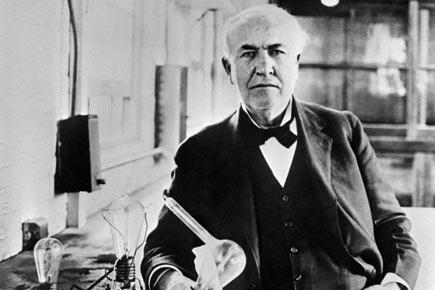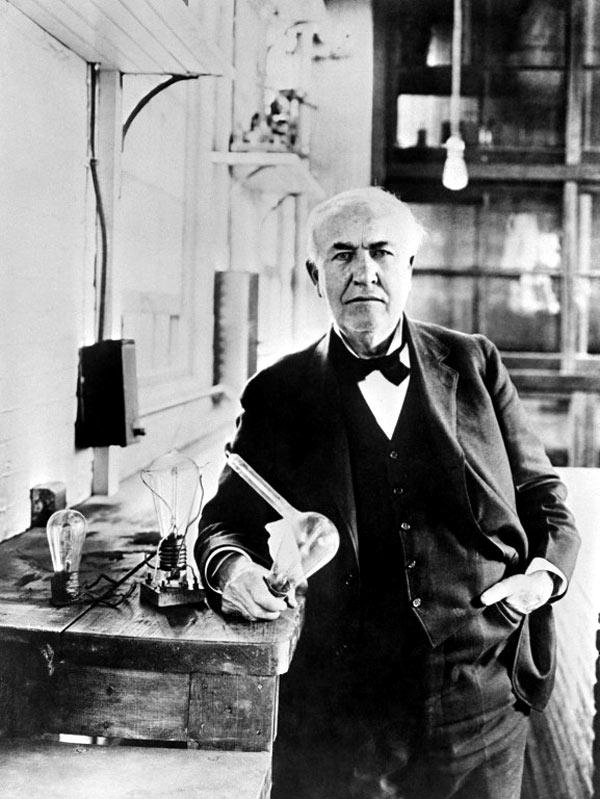On Thomas Edison's 85th death anniversary, we look back at some of his most famous innovations that went on to shape the future world...

Great inventor, Thomas Alva Edison, Thomas Edison, The Wizard of Menlo Park, electric power, electric light bulb, phonograph, Motion pictures

Undated file portrait of Thomas Edison
A prolific inventor, holding 1,093 US patents in his name, he developed many devices that greatly influenced life around the world, including the phonograph, the motion picture camera, and a long-lasting, practical electric light bulb.
ADVERTISEMENT
Edison, who was bestowed upon with the nickname, "The Wizard of Menlo Park" was one of the first inventors to apply the principles of mass production and large-scale teamwork to the process of invention, and because of that, he is often credited with the creation of the first industrial research laboratory.
Notable inventions by Thomas Edison
The phonograph: One of Thomas Edison's first inventions that gained him mainstream attention was the phonograph, which he invented in Newark, New Jersey in 1877. It was an early version of the gramaphone, a device used for the mechanical recording and reproduction of sound especially music. Edison's first phonograph recorded on tinfoil around a grooved cylinder. Despite its limited sound quality and that the recordings could be played only a few times, the device made him a celebrity. His accomplishment was so unexpected by the public at large as to appear almost magical and thus he became known as "The Wizard of Menlo Park," New Jersey.
Carbon telephone transmitter: In 1877–78, Edison invented and developed the carbon microphone used in all telephones along with the Bell receiver until the 1980s. After protracted patent litigation, in 1892 a federal court ruled that Edison and not Emile Berliner was the inventor of the carbon microphone. The carbon microphone was also used in radio broadcasting and public address work through the 1920s.
The electric light becomes a commerical entity: Although Thomas Edison did not invent the first electric light bulb, he invented the first commercially practical incandescent light. After many experiments, first with carbon filaments and then with platinum and other metals, in the end Thomas Edison returned to a carbon filament. The first successful test was on October 22, 1879; it lasted 13.5 hours. Edison continued to improve this design and by November 4, 1879, filed for U.S. patent 223,898 (granted on January 27, 1880) for an electric lamp using "a carbon filament or strip coiled and connected to platina contact wires".
Electric power distribution becomes a reality: To capitalize on the invention of electric lamp, Thomas Edison patented a system of eletricity distribution. He had devised a commercially viable electric light bulb on October 21, 1879 and thus felt that the step was necessary.
Edison became founder of the Edison Illuminating Company in December 17 1880 and established the first investor-owned electric utility in 1882 on Pearl Street Station, New York City. It was on September 4, 1882, that Edison switched on his Pearl Street generating station's electrical power distribution system, which provided 110 volts direct current (DC) to 59 customers in lower Manhattan.[63]
Earlier in the year, in January 1882, he had switched on the first steam-generating power station at Holborn Viaduct in London. The DC supply system provided electricity supplies to street lamps and several private dwellings within a short distance of the station. On January 19, 1883, the first standardized incandescent electric lighting system employing overhead wires began service in Roselle, New Jersey.
Motion picture pioneer: Edison was also granted a patent for the motion picture camera or "Kinetograph". He did the electromechanical design, while his employee W.K.L. Dickson, a photographer, worked on the photographic and optical development. Much of the credit for the invention belongs to Dickson.
In 1891, Thomas Edison built a Kinetoscope, or peep-hole viewer. This device was installed in penny arcades, where people could watch short, simple films. The kinetograph and kinetoscope were both first publicly exhibited May 20, 1891.
In April 1896, Thomas Armat's Vitascope, manufactured by the Edison factory and marketed in Edison's name, was used to project motion pictures in public screenings in New York City. Later he exhibited motion pictures with voice soundtrack on cylinder recordings, mechanically synchronized with the film.
Edison's film studio made close to 1,200 films. The majority of the productions were short films showing everything from acrobats to parades to fire calls including titles such as Fred Ott's Sneeze (1894), The Kiss (1896), The Great Train Robbery (1903), Alice's Adventures in Wonderland (1910), and the first Frankenstein film in 1910. In 1903, when the owners of Luna Park, Coney Island announced they would execute Topsy the elephant by electrocution, Edison Manufacturing sent a crew to film it, releasing it that same year with the title Electrocuting an Elephant.
Edison lost a legal battle against William Fox, who pioneered the use of wide screen cinema. This caused him to drop his interest in motion pictures, altogether.
The stock ticker: One of the earliest practical stock ticker machines, the Universal Stock Ticker developed by Thomas Edison in 1869, used alphanumeric characters with a printing speed of approximately one character per second.
Stock ticker machines are an ancestor of the modern computer printer, being one of the first applications of transmitting text over a wire to a printing device, based on the printing telegraph. This used the technology of the then-recently invented telegraph machines, with the advantage that the output was readable text, instead of the dots and dashes of Morse code. A special typewriter designed for operation over telegraph wires was used at the opposite end of the telegraph wire connection to the ticker machine. Text typed on the typewriter was displayed on the ticker machine at the opposite end of the connection.
Did you know?
Fellow inventor Nikola Tesla worked for Edison for two years at the Continental Edison Company in France starting in 1882, and another year at the Edison Machine Works in New York City ending in a disagreement over pay.
Having had scarlet fever as a child, Thomas Edison lost all hearing in his left ear and had 10 per cent hearing in his right ear.
Edison said his favorite movie was The Birth of a Nation. He thought that talkies had "spoiled everything" for him. "There isn't any good acting on the screen. They concentrate on the voice now and have forgotten how to act. I can sense it more than you because I am deaf." His favorite stars were Mary Pickford and Clara Bow.
Thomas Edison is the only person in the U.S. to receive a patent every year for 65 years (1868-1933).
By the 1880s, there were about a thousand stock tickers installed in the offices of New York bankers and brokers.
Thomas Edison's first patented invention, 'The Electrical Vote Recorder,' was deemed by congress not useful because it counted votes too quickly.
 Subscribe today by clicking the link and stay updated with the latest news!" Click here!
Subscribe today by clicking the link and stay updated with the latest news!" Click here!







